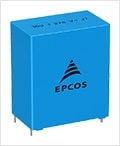source: TDK news
TDK Corporation presents a series of robust EPCOS MKP film capacitors (B3275*) that are optimized for use with AC voltages with high ripple currents. The new types are available for rated voltages of 250 VRMS, 275 VRMS and 310 VRMS and cover a capacitance range from 1 µF to 70 µF.
One particular feature is their extreme robustness: The capacitors pass a THB test (temperature, humidity, bias) at 60 °C, 95 percent relative humidity and a rated voltage applied for 1000 hours.
The MKP film capacitors are designed for a maximum operating temperature of 105 °C: Both their case and the epoxy resin sealing comply with UL 94 V-0. Depending on capacitance and voltage class, the lead spacings are 27.5 mm, 37.5 mm or 52.5 mm, with 4-pin versions offered for the two larger lead spacings.
The capacitors feature a long expected lifetime of more than 60,000 hours at a temperature of 70 °C and 90 percent of the rated voltage. Typical applications for the new EPCOS MKP film capacitors are the output filters of frequency converters, uninterruptible power supplies and variable-speed drives.
Main applications
- Output filters of converters
- Uninterruptible power supplies
- Controlled drives
Main features and benefits
- Extreme robustness, verified in a THB test at 60 °C, 95 percent relative humidity and a rated voltage applied for 1000 hours
- Long expected lifetime of more than 60,000 hours at a temperature of 70 °C and 90 percent of the rated voltage
































